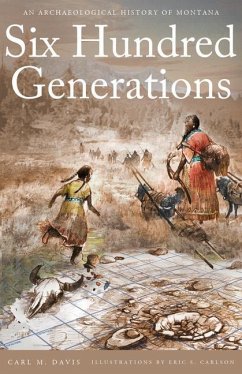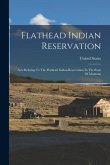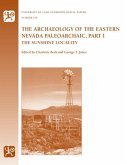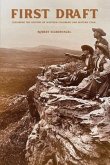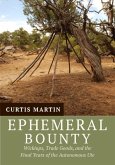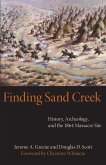Carl M. Davis
Six Hundred Generations: An Archaeological History of Montana
Schade – dieser Artikel ist leider ausverkauft. Sobald wir wissen, ob und wann der Artikel wieder verfügbar ist, informieren wir Sie an dieser Stelle.
Carl M. Davis
Six Hundred Generations: An Archaeological History of Montana
- Broschiertes Buch
- Merkliste
- Auf die Merkliste
- Bewerten Bewerten
- Teilen
- Produkt teilen
- Produkterinnerung
- Produkterinnerung
Montana human history from Pleistocene to 1800s, based on archaeological studies.
Andere Kunden interessierten sich auch für
![Flathead Indian Reservation: Acts Relating To The Flathead Indian Reservation In The State Of Montana Flathead Indian Reservation: Acts Relating To The Flathead Indian Reservation In The State Of Montana]() United StatesFlathead Indian Reservation: Acts Relating To The Flathead Indian Reservation In The State Of Montana16,99 €
United StatesFlathead Indian Reservation: Acts Relating To The Flathead Indian Reservation In The State Of Montana16,99 €![The Archaeology of the Eastern Nevada Paleoarchaic, Part 1: The Sunshine Locality Volume 126 The Archaeology of the Eastern Nevada Paleoarchaic, Part 1: The Sunshine Locality Volume 126]() Charlotte BeckThe Archaeology of the Eastern Nevada Paleoarchaic, Part 1: The Sunshine Locality Volume 12645,99 €
Charlotte BeckThe Archaeology of the Eastern Nevada Paleoarchaic, Part 1: The Sunshine Locality Volume 12645,99 €![First Draft: Exploring the History of Western Colorado and Eastern Utah First Draft: Exploring the History of Western Colorado and Eastern Utah]() Robert SilbernagelFirst Draft: Exploring the History of Western Colorado and Eastern Utah26,99 €
Robert SilbernagelFirst Draft: Exploring the History of Western Colorado and Eastern Utah26,99 €![Ephemeral Bounty: Wickiups, Trade Goods, and the Final Years of the Autonomous Ute Ephemeral Bounty: Wickiups, Trade Goods, and the Final Years of the Autonomous Ute]() Curtis MartinEphemeral Bounty: Wickiups, Trade Goods, and the Final Years of the Autonomous Ute56,99 €
Curtis MartinEphemeral Bounty: Wickiups, Trade Goods, and the Final Years of the Autonomous Ute56,99 €![Finding Sand Creek: History, Archeology, and the 1864 Massacre Site Finding Sand Creek: History, Archeology, and the 1864 Massacre Site]() Jerome A. GreeneFinding Sand Creek: History, Archeology, and the 1864 Massacre Site19,99 €
Jerome A. GreeneFinding Sand Creek: History, Archeology, and the 1864 Massacre Site19,99 €![Archaeological Research in the Northeastern San Juan Basin of Colorado During the Summer of 1921 Archaeological Research in the Northeastern San Juan Basin of Colorado During the Summer of 1921]() Jean Allard JeanconArchaeological Research in the Northeastern San Juan Basin of Colorado During the Summer of 192118,99 €
Jean Allard JeanconArchaeological Research in the Northeastern San Juan Basin of Colorado During the Summer of 192118,99 €![Denver Denver]() Sarah M NelsonDenver34,99 €
Sarah M NelsonDenver34,99 €
Montana human history from Pleistocene to 1800s, based on archaeological studies.
Produktdetails
- Produktdetails
- Verlag: Globe Pequot Press
- Seitenzahl: 320
- Erscheinungstermin: 2. Juli 2019
- Englisch
- Abmessung: 213mm x 137mm x 18mm
- Gewicht: 522g
- ISBN-13: 9781606391112
- ISBN-10: 1606391119
- Artikelnr.: 53777443
- Herstellerkennzeichnung
- Libri GmbH
- Europaallee 1
- 36244 Bad Hersfeld
- gpsr@libri.de
- Verlag: Globe Pequot Press
- Seitenzahl: 320
- Erscheinungstermin: 2. Juli 2019
- Englisch
- Abmessung: 213mm x 137mm x 18mm
- Gewicht: 522g
- ISBN-13: 9781606391112
- ISBN-10: 1606391119
- Artikelnr.: 53777443
- Herstellerkennzeichnung
- Libri GmbH
- Europaallee 1
- 36244 Bad Hersfeld
- gpsr@libri.de
Raised in Dillon, Montana, Carl M. Davis received a bachelor's degree in anthropology from the University of Montana and a master's degree in anthropology from the University of Pittsburgh. He worked for 35 years as an archaeologist on national forests in Montana and Oregon, and in 2015 retired as the Regional Archaeologist for the U.S. Forest Service Northern Region in Missoula, Montana. For his dedication to preserving and promoting Montana history, Davis received the 2018 Montana Heritage Keeper Award, presented by the Montana Historical Society Board of Trustees. He resides in Missoula with his partner, Sara Scott.
Contents
1. Preface: First Things
2. Not One Story but Many
3. Climate Past and Present
4. How Archaeologists Learn about the Past
5. Coming into the Country
6. Ice Age Montanans: Anzick Site
7. Horns and Spears: Mill Iron Site
8. Not by Meat Alone: Barton Gulch Site
9. Wintering Over: Spiro Site
10. Pine Parkland Living: Pictograph and Ghost Caves
11. Rock Knocking: Schmitt Chert Mine
12. "Deep Blood Kettle": First Peoples Buffalo Jump
13. Warrior Artists: Bear Gulch and Atherton Canyon
14. Frontier Farmers: Hagan Village Site
15. Mountaineers: Wickiup Cave
16. Rifles and Coups: Battle of the Rosebud
17. Lines Drawn in the Earth: Absaroka Agency
18. Connecting Past and Present
19. The Way Forward
Glossary
Bibliography
Acknowledgements
Index
1. Preface: First Things
2. Not One Story but Many
3. Climate Past and Present
4. How Archaeologists Learn about the Past
5. Coming into the Country
6. Ice Age Montanans: Anzick Site
7. Horns and Spears: Mill Iron Site
8. Not by Meat Alone: Barton Gulch Site
9. Wintering Over: Spiro Site
10. Pine Parkland Living: Pictograph and Ghost Caves
11. Rock Knocking: Schmitt Chert Mine
12. "Deep Blood Kettle": First Peoples Buffalo Jump
13. Warrior Artists: Bear Gulch and Atherton Canyon
14. Frontier Farmers: Hagan Village Site
15. Mountaineers: Wickiup Cave
16. Rifles and Coups: Battle of the Rosebud
17. Lines Drawn in the Earth: Absaroka Agency
18. Connecting Past and Present
19. The Way Forward
Glossary
Bibliography
Acknowledgements
Index
Contents
1. Preface: First Things
2. Not One Story but Many
3. Climate Past and Present
4. How Archaeologists Learn about the Past
5. Coming into the Country
6. Ice Age Montanans: Anzick Site
7. Horns and Spears: Mill Iron Site
8. Not by Meat Alone: Barton Gulch Site
9. Wintering Over: Spiro Site
10. Pine Parkland Living: Pictograph and Ghost Caves
11. Rock Knocking: Schmitt Chert Mine
12. "Deep Blood Kettle": First Peoples Buffalo Jump
13. Warrior Artists: Bear Gulch and Atherton Canyon
14. Frontier Farmers: Hagan Village Site
15. Mountaineers: Wickiup Cave
16. Rifles and Coups: Battle of the Rosebud
17. Lines Drawn in the Earth: Absaroka Agency
18. Connecting Past and Present
19. The Way Forward
Glossary
Bibliography
Acknowledgements
Index
1. Preface: First Things
2. Not One Story but Many
3. Climate Past and Present
4. How Archaeologists Learn about the Past
5. Coming into the Country
6. Ice Age Montanans: Anzick Site
7. Horns and Spears: Mill Iron Site
8. Not by Meat Alone: Barton Gulch Site
9. Wintering Over: Spiro Site
10. Pine Parkland Living: Pictograph and Ghost Caves
11. Rock Knocking: Schmitt Chert Mine
12. "Deep Blood Kettle": First Peoples Buffalo Jump
13. Warrior Artists: Bear Gulch and Atherton Canyon
14. Frontier Farmers: Hagan Village Site
15. Mountaineers: Wickiup Cave
16. Rifles and Coups: Battle of the Rosebud
17. Lines Drawn in the Earth: Absaroka Agency
18. Connecting Past and Present
19. The Way Forward
Glossary
Bibliography
Acknowledgements
Index

